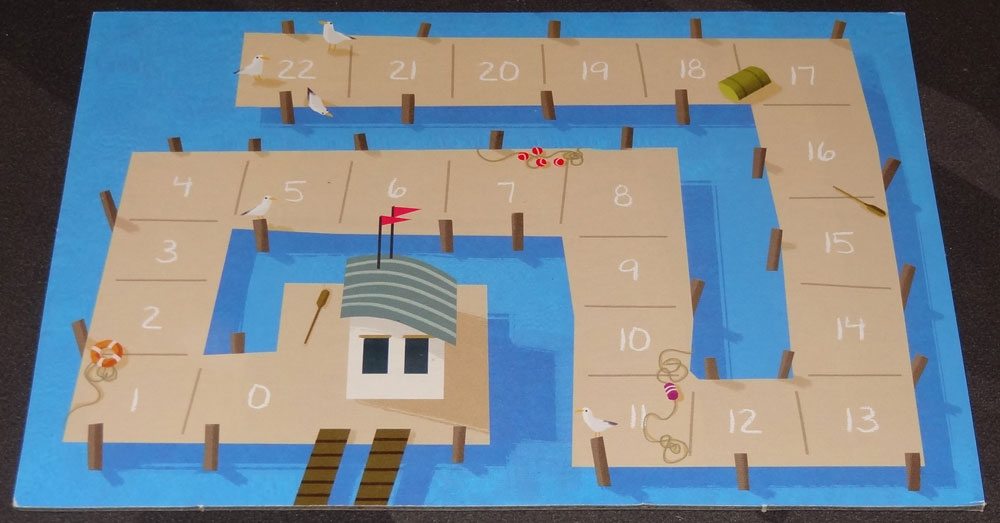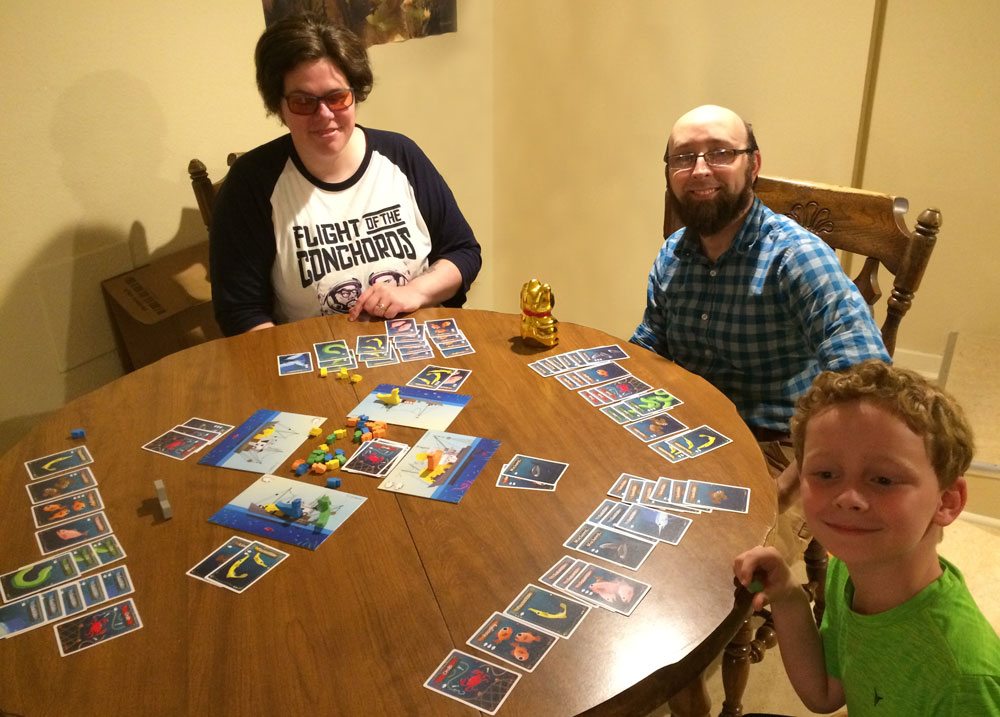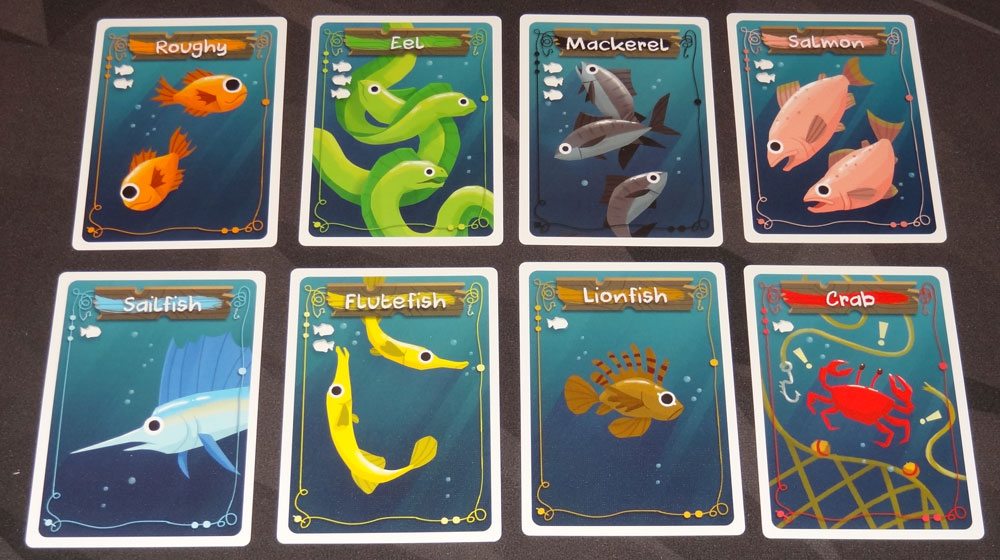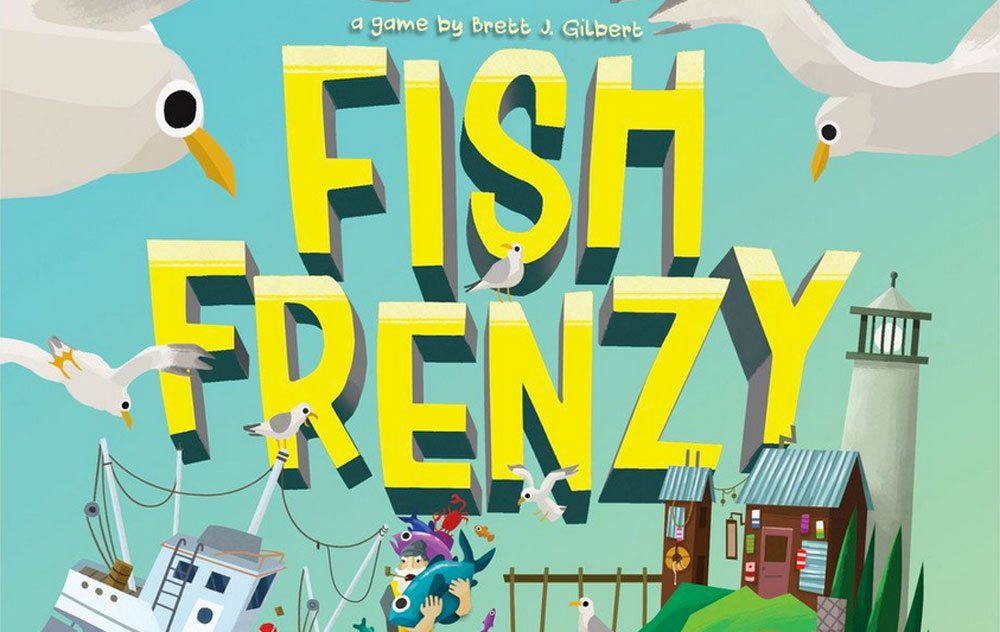Rainbow Bay is known for its colorful fish… and the hungry seagulls who await each day’s catch. In Fish Frenzy, you and your opponents try to fill up on fish, while avoiding the crabs and their waving pincers.
At a glance: Fish Frenzy is a game designed by Brett J. Gilbert for 3 to 5 players, ages 10 and up, and takes about 30 minutes to play. It retails for $29.99 and is available for pre-order directly from Crash of Games—the game should be released in August, and pre-orders will have some promo achievement cards included. I would say the game can be taught to younger kids, maybe as young as 6, though older players will usually have a little bit of an advantage as far as figuring out some of the strategy. It’s a set-collection game about eating fish and trying to get the best combinations to score the most points.

Components
- 80 Fish and Crab cards (10 each of 7 types of fish, and crabs)
- 5 Seagull pawns
- 1 Boat pawn
- 5 Captain Boat boards
- 40 Little Fish pawns (8 per player)
- 5 Goal cards
- 5 Event cards

The components for Fish Frenzy are pretty nice: big, colorful, chunky wooden pieces, and artwork on the boards and cards by Kwanchai Moriya. My kids thought the seagulls looked a little like seals, but I suppose they eat fish, too. And the boat pawn, which marks the starting player, is enormous. It kind of makes you wish you could use it for something in the game rather than just passing it around to indicate starting player—my kids end up stacking their fish and seagull tokens on it, and then whining when they have to pass it along.

The Captain Boat boards are marked for the number of players you use, and each one has a scoring track on the back so that at the end of the game you can just flip one over and use it to add up scores. Just remember to flip it over: one time I played and we were all trying to do that in our heads, which is possible but more error-prone.

My only gripe about the components is my personal pet peeve: the box size. The boards are the largest thing in the box and seem to be the limiting factor (other than the rulebook itself), but they’re actually only half the size of the box, so the box is literally half empty. Or maybe half full. At any rate, I’ll keep complaining about box sizes until the industry changes—so I guess expect to hear more about that for a long, long time.

How to Play
You can download a copy of the rules here.
The goal of the game is to score the most points, which you do by collecting the most of each particular type of fish (and avoiding crabs). Throughout the game, you’ll be competing for the various boats based on what they caught, and then you decide whether to eat the fish (to help you push other seagulls around) or collect them for points.

To set up, you start with as many boats as there are players, in the center of the table—the boats have 0, 1, or 2 little fish marked in the corner. The Fish & Crab cards are shuffled together in a deck. Everyone gets a Seagull and four matching little fish. The rest of the little fish are placed in a supply in the center, and the youngest player gets the Boat pawn.
Each round, you deal out two cards next to each boat (keeping them in order). Then, play begins and players jockey for position on the boats.
On your turn, you place your Seagull on any of the boats. If it’s unoccupied, you’re done. If it’s occupied, then there’s a challenge. You must place little fish with your Seagull to challenge, placing one more than the number of fish the other player has. The other player must immediately either leave and move to another boat, or respond to the challenge by adding more fish until they outnumber you. (I like to think of it as throwing your weight around, since you get little fish by eating rather than collecting fish—so the more you eat, the more you can push other Seagulls off your boat.)
Turns continue like this until there is exactly one Seagull on each boat, and it’s time to sort the catch.
Any little fish tokens played are now put back into the supply (not returned to players). Then, starting with the smallest boat (the one with 0 little fish in the corner), the player occupying the boat decides whether to collect or eat.

To collect, simply take all of the cards next to the boat and place them in front of you, grouped by type of fish (and crab).
To eat, remove the last (most recently played) card next to the boat, and take your little fish from the supply equal to the amount shown on the card plus the number of little fish on the boat board. The card goes into the discard pile, not into your collection.
If the draw deck is now empty, the game is over. Otherwise, pass the Boat pawn and start a new round by placing 2 more fish in each boat.

At the end of the game, you score 3 points if you have the most Fish cards of a color, and 1 point if you have second-most. (If there are ties for first, everyone tied gets 2 points, and no points are awarded for second place.) Each Crab card is -1 point.
Highest score wins; ties go to the player with more little fish, and then the player with fewest Crabs.
There are also optional Goal and Event cards: simply reveal 1 Goal and 1 Event card at the beginning of the game, and these will award bonus victory points for certain conditions, like having complete sets of all 7 colors, or even bonus points for having the most Crabs.

The Verdict
Fish Frenzy is a clever little set-collection game. The basic idea behind the set-collection part is simple: get the most of a type of fish to score points, and avoid crabs. However the way you collect those cards introduces some interesting dynamics, and a particularly delicious choice: do I collect cards for points now, or eat fish so that I can potentially collect a better catch later?
In order to force somebody off a boat, you have to spend more little fish than them. But the only way to get more little fish is to skip an opportunity to add to your collection, so you want to make the most of it. Sometimes it makes sense to eat because the last fish is a crab and you don’t want to collect it—but crabs are only worth 1 little fish. There’s often some competition over the last boat, the one with 2 little fish icons, because when you eat there, you get more bang for your buck. Or you might eat because you know there’s no chance to compete over a particular type of fish, so you might as well prepare for your next challenge. The little fish can also serve as a deterrent, too: if you collect a whole bunch of fish, other players may avoid your boat, simply because they don’t want to spend all their own fish and still walk (fly) away with nothing to show for it. On the other hand, having a whole lot of little fish often means you haven’t been collecting cards—it’s costing you at least two cards each time you eat.

In terms of the set collection, you have to keep a close eye on what your opponents are collecting. You don’t want to be third place for a fish, or in second place when people are tied for first. The best times to challenge somebody are when you can prevent them from taking first place for a particular type of fish, or get yourself into the lead. The optional cards throw a new wrinkle into that, too, giving you alternative strategies for earning some points.
Overall, Fish Frenzy is not too challenging to learn, so it’s a family-friendly game and good for kids and those who like more casual games. It may not be as filling for those who want the heavy strategy games, but does at least offer some interesting choices in a short game, and while there is a little bit of luck in the card dealing, it’s more about choices: whether to challenge or not, and whether to collect or eat. My kids particularly enjoyed fighting over boats—and I highly encourage shouting “Mine? Mine? Mine?” while you do that.
To order a copy of Fish Frenzy, visit the Crash of Games website, or look for it in stores near the end of August.
Disclosure: I received a review copy of this game.





